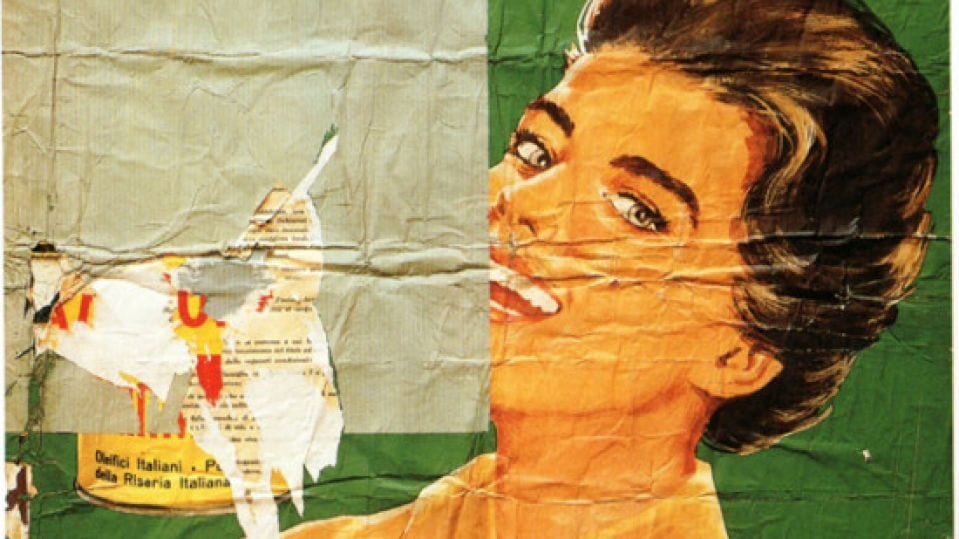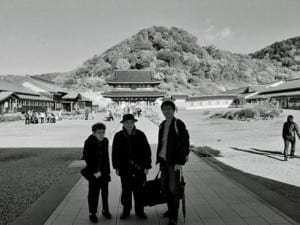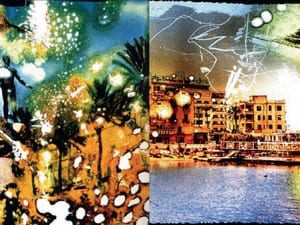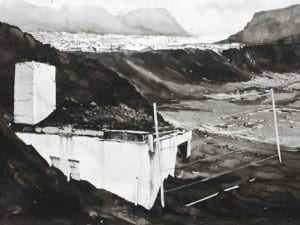In a career spanning more than 50 years, Mimmo Rotella experimented with a number of different working methods, trying to overcome the traditional languages of expression and representation. This exhibition at Robilant + Voena, London, curated by Antonella Soldaini, brings together work from across his entire career, demonstrating an array of forms and styles which remain as powerful now as they ever were.
The exhibition shows a number of different techniques, including decollages, found posters lacerated with a brush or knife and attached to different supports, retro d’affiches, the same technique applied to the verso of the poster, blanks, monochrome papers used to obscure images, and photographic reproductions on canvas. The works feel strikingly contemporary in their appropriation of popular media imagery, which is making a comeback in the digital arts, but they are also of their time, containing elements of Pop art and Italian Futurism.
The interesting thing is not so much the difference in technique as the continuity in subject matter. Advertising, cinema, politics and the media changed dramatically over the course of the period in which Rotella was working, but they ultimately just proliferated. Consequently, the modern world furnished Rotella with ever more material for his ongoing investigations of materiality and method. You get the feeling that it was this abundance that inspired the use of collage, as an attempt to get as much of the ever-expanding world as possible in to the canvas. Add to this the fact that Rotella began his career as a painter of geometric abstractions, which he abandoned to engage with the real world outside the studio, and the work seems like an attempt to deal with being constantly inundated with imagery.
The aesthetic line running through Rotella’s work traces the movement of art history itself. Early works, such as Collage 12 (1954) and Levigo con macchie (1956) feel like hangovers from abstract expressionism with their impasto mix of colours hastily torn from found posters. Then glimmers of Pop art begin to emerge in Divertiamoci (1966) and Cavalcata selvaggia (1966), where colour becomes more vibrant and images are foregrounded. The politicised 1970s, along with an increased interested in photography as fine art, appears in Italy in torment (1979), a photographic reproduction the cover of Time magazine. Finally, the death of painting arrives in Blank crepato (1980), an imposing monochrome black sheet roughly pasted over a poster; it has air bubbles and creases which from a distance look like brushstrokes, as if to express the notion that painterly expression is an illusion in the modern age. Rotella, in this sense, was always contemporary.
Rotella’s images are captivating because they marry iconography with the brutality of the process of tearing, cutting and appropriating the ravages of the elements of posters found on city walls. This is best exemplified in Puoi acquistare (1990), where the stilettos pulsate on a background of roughhewn paper. For all the delight in the proliferation of culture in these works, there is also a starkness to the later works on zinc, like Blank metal (1992), where the metal protrudes, corroding and cold as if to remind us not to get too consumed in the sea of images.
Mimmo Rotella, until 24 March, Robilant + Voena, 38 Dover Street, London, W1S 4NL.
Daniel Barnes
Credits
1. Mimmo Rotella –Arachidina 1963 138 x 95.3cm.





